Samsung Music Frame hands-on: invisible audio done right
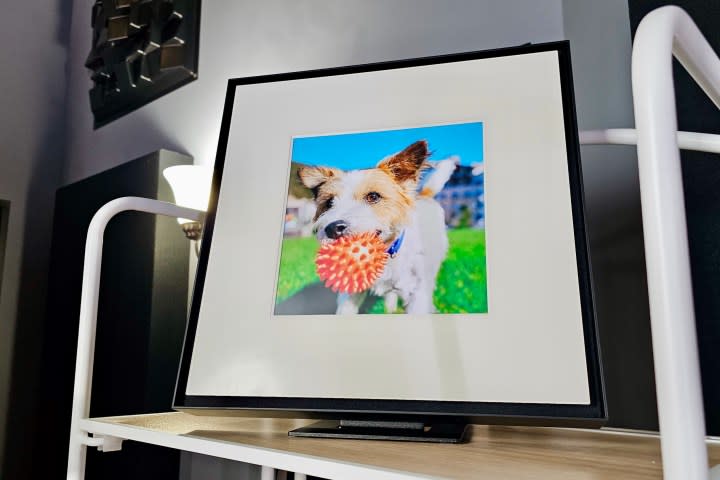
Wireless speakers aren’t exactly an interior designer’s idea of good home decor. Companies know this, which is why we’ve seen a variety of attempts at making these objects less objectionable. Some speakers, like the Apple HomePod and Google Nest families, use gentle fabric wraps and rounded shapes to soften their appearance. Others, like Marshall’s line of guitar amp-inspired models or JBL’s Authentics, go the other direction, with a retro vibe that aims to be a focal point, perhaps even a conversation starter.
Samsung’s Sneaky Speaker Has Surprisingly Massive Sound | Music Frame Quick Impressions
And then there are the chameleons: speakers that disguise themselves as other room elements, like the Sonos-powered Ikea Symfonisk family of table lamps, bookshelves, and artwork. It’s in this category that Samsung has placed its new $400 Music Frame speaker.
I recently got a chance to spend a few hours playing around with it (along with a Frame TV and Samsung’s HW-Q990D soundbar) at a Samsung facility in New Jersey, and I think the Music Frame might just be the most successful attempt yet at creating high-quality, yet invisible audio.
Digital audio, not art
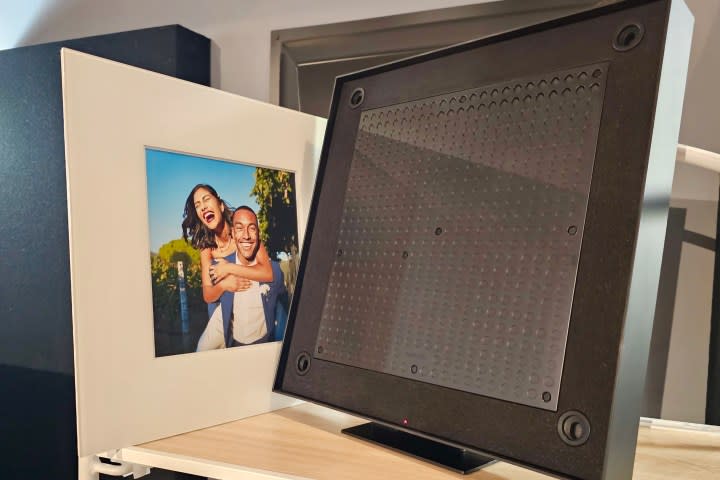
First things first: The Music Frame is not a digital photo frame. Why not? Well, for one thing, it would have increased the price. But more likely is that Samsung wanted the Music Frame to truly blend with its environment. Digital frames may be fun and versatile, but they have a way of calling attention to themselves.
Instead, the Music Frame gives you two options for displaying your preferred images. The included mounting panel — which attaches to the front of the speaker like a traditional speaker grille with a set of four ball-and-socket posts — lets you insert any 8×8-inch or 8×10-inch printed photo.
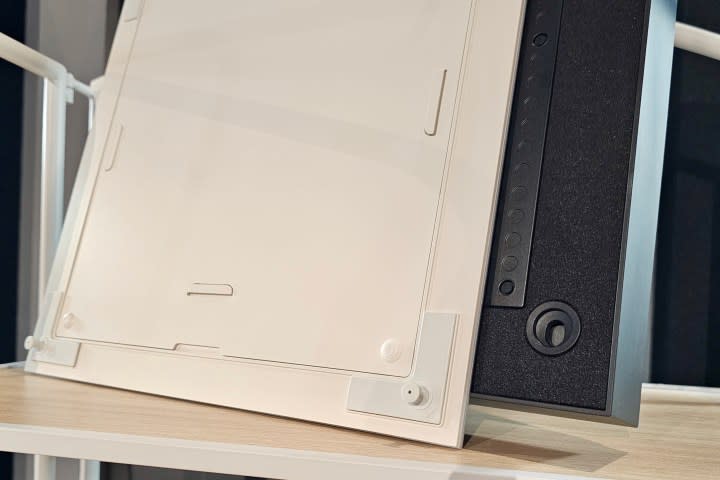
The other option, for which Samsung has yet to provide details, is to replace that photo-holder panel with a custom-printed one. When Samsung debuted the Music Frame at CES 2024, it had several of these glossy versions on-hand — each with artwork that extended all the way to the edge of the panel.
We don’t yet know how much these will cost, which companies will print and ship them, or how long they take to be made once ordered. What we do know is that you’ll be able to buy a white bezel from Samsung later this year that can cover the existing black frame seen in these photos.
Admittedly, the Music Frame is a good bit chunkier than your average 8×10 picture frame. At 13.8×13.8 inches and a hair over 2 inches thick, it may not fit on smaller surfaces like shallow fireplace mantels. And at a surprisingly heavy 9.3 pounds, a solid surface is definitely recommended.
Stand or wall-mounted
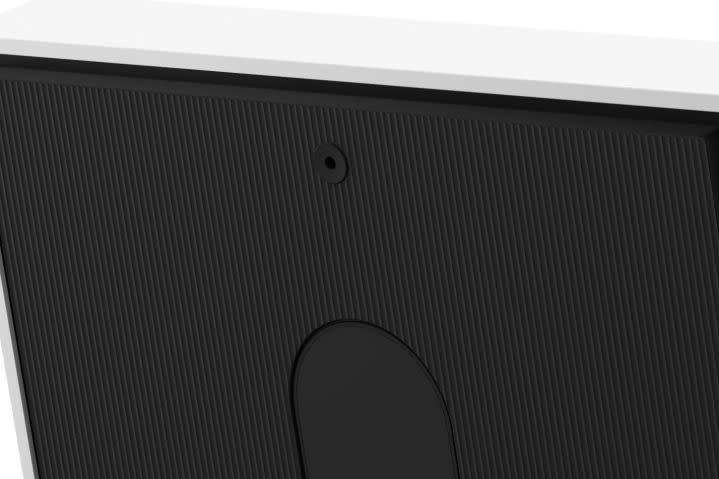
Samsung includes both an angled stand (seen here) and a wall mount kit with every Music Frame. I didn’t get a chance to see the wall mount kit, but a standard threaded mounting hole on the back of the Frame hints at how it will attach.
According to Samsung, it sits entirely flush to your wall. That makes me super curious about the two subwoofers on the rear of the speaker . Will they create unwanted vibrations? (More on the sound in a moment.)
The real question is whether you’ll be OK with the power cable dangling down the wall. To Samsung’s credit, it has tried to make the cable thin and somewhat transparent. It’s a big improvement over the thick, fabric-wrapped cable that ships with the Ikea Symfonisk Picture Frame speaker. Still, a cable is a cable.
Connections galore
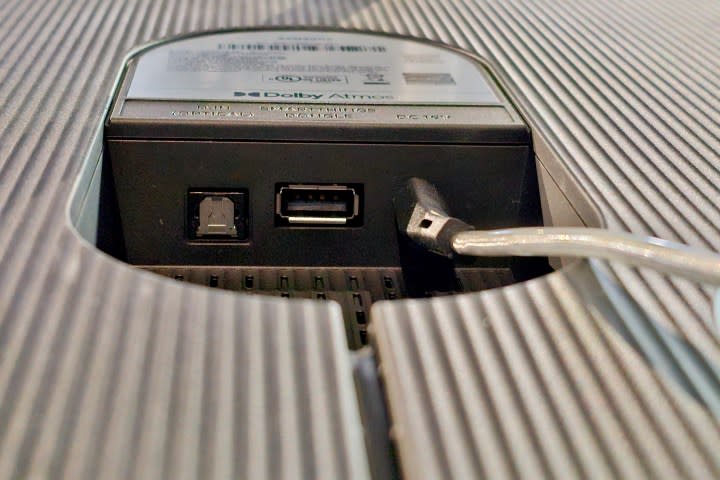
Samsung went to town on the Music Frame’s wireless audio connections. It’s all here: Bluetooth, Apple AirPlay, Chromecast, Spotify Connect, and Tidal Connect. The Frame can also act as an Amazon Alexa smart speaker, which means you get Alexa Cast too.
That’s an impressive array of choices, especially for Android users who can’t take advantage of AirPlay. Sonos, it should be noted, supports most of these connections as well, but not Chromecast. Does that matter? If you’re a fan of lossless hi-res audio, then yes — AirPlay is limited to CD-quality lossless at 16-bit/44.1kHz, whereas Chromecast supports up to 24-bit/96kHz.
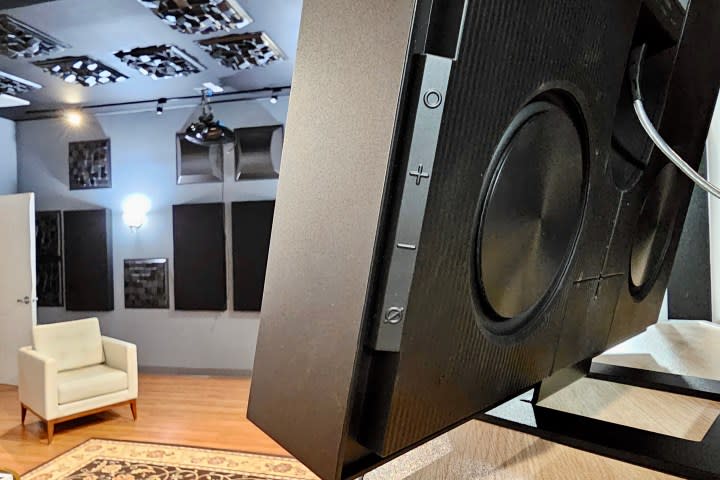
There’s even an optical port. It’s a bit of strange inclusion on a wireless speaker, but given that you may end up positioning the Music Frame near a TV, it could be helpful. My experience suggests the Frame could make for a very capable soundbar replacement in smaller rooms.
Plus, I’d be remiss if I didn’t mention one of Samsung’s favorite features: Q-Symphony. This lets you send audio wirelessly from a compatible Samsung TV to as many as two Music Frames. Alternatively, a single Music Frame can act as a wireless surround-center channel speaker when used with a compatible Samsung TV and soundbar (like the HW-Q990D).
SmartThings control
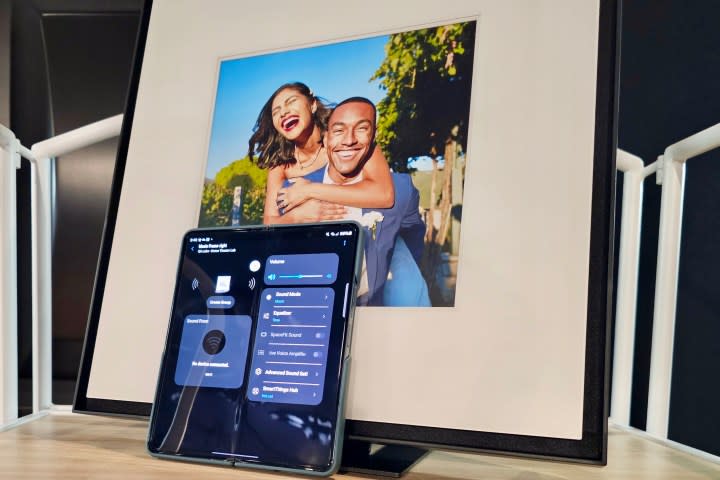
It’s clear that Samsung knows how to build a quality wireless speaker, but I’m not super stoked by its choice of software. Instead of a dedicated app for music control like Sonos, Samsung leverages its jack-of-all-trades SmartThings app to oversee the Frame’s functions.
We had our fair share of Wi-Fi issues at Samsung’s location, but even setting those aside, I found the SmartThings app to be clunky and hard to use. Maybe I just need to get more familiar with the various menus (or maybe Samsung is still working on them), but even a basic function like getting two Music Frames to play as a stereo pair proved impossible for me. even with Samsung’s assistance.
There’s also no central music management within the SmartThings app. All of your music must be streamed from a third-party app like Apple Music or Spotify, which is less convenient, especially when trying to manage multiple speakers in multiple rooms.
Remarkably expansive sound
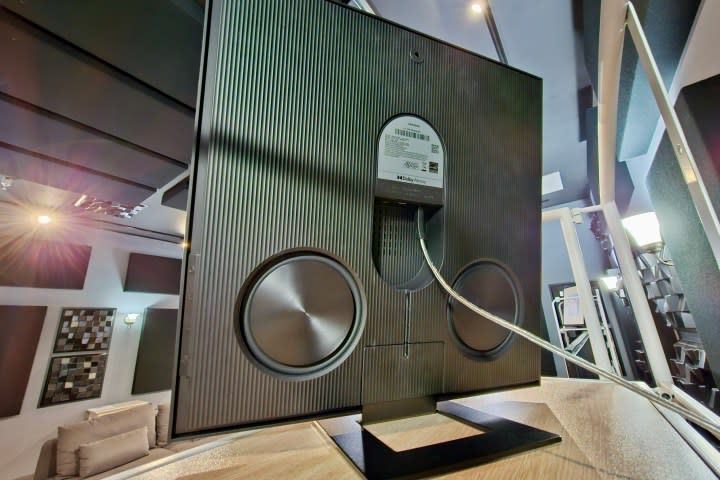
Any time a speaker exceeds my expectations for sound quality, it brings a smile to my face, and the Samsung Music Frame had me grinning from ear to ear. There’s simply no way that someone walking into a room and hearing what this device can do will believe that it’s all coming from what appears to be a regular photo frame.
This stands in stark contrast to the Ikea Symfonisk Picture Frame, which sounds OK, but not special in any way.
Not only does the Frame get loud (really loud, if you want), but those subwoofers produce an exceptional amount of low-end. Did I mention that you can use the Music Frame just as a subwoofer? You can, and though I haven’t heard it in this role, I don’t doubt its effectiveness.
However, the best part, as far as I’m concerned, is what the Music Frame does with Dolby Atmos Music content. Despite not having any dedicated, up-firing drivers like Sonos’ $449 Era 300 (which also does Dolby Atmos), the Frame nonetheless creates a very convincing immersive soundstage that is both tall and wide.
Stereo tracks weren’t quite as impressive, but in fairness, I was more focused on the Atmos material, so I’ll withhold any judgment for now.
More to come
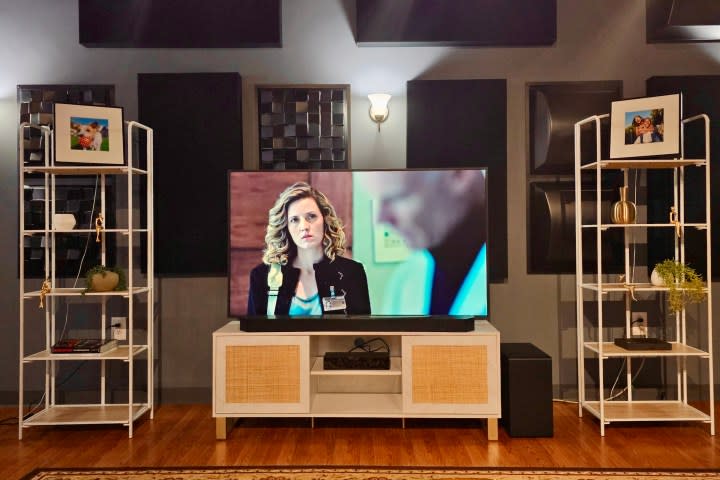
A handful of hours is not enough to really dig into a product like the Music Frame, but I’m already very impressed by what I’ve seen and heard.
As soon as Samsung releases full review units, I’ll be able to offer a fuller evaluation. Here’s what I still need to try:
Wall-mounting: How much of a pain is it, how does it affect sound quality, and will that cable drive me crazy?
Stereo-pairing: Hopefully I’ll be sent two Frames so I can see if this actually works.
TV audio: Despite having a Samsung Frame TV on hand during my demo time, I’m not sure I got that part working correctly. I don’t have a Frame TV, but my neighbor does. Looks like I’ll have to buy him pizza.
Using the Frame as an Alexa smart speaker.
That SmartThing app: Maybe I’ll have better luck on my own phone, with reliable Wi-Fi.
Customization: I’ll stick a few photos in that panel and see how tricky it is to switch them up.
More music: I’m just going to play way more tunes. All kinds of tunes.
Stay tuned!

